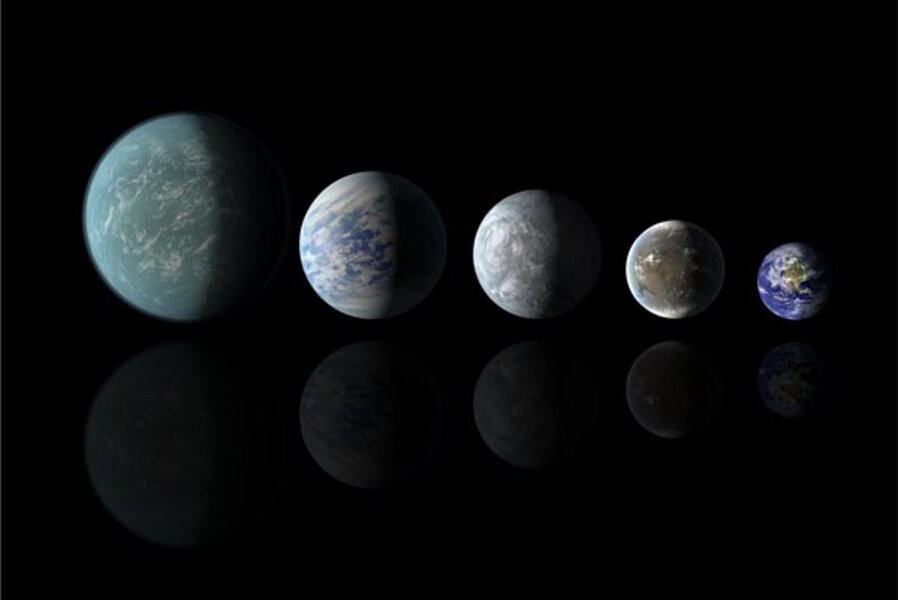Livable super-Earths? Two candidates among Kepler's latest finds.
Loading...
Two potentially livable super-Earths and an outsized version of Venus were unveiled Thursday, the latest in a string of remarkable discoveries from NASA's Kepler mission.
Kepler is a space-based observatory whose unblinking gaze has rested on some 170,000 stars simultaneously since May 2009.
The three planets are the smallest the observatory has yet detected in stellar habitable zones. These zones represent distances where a planet receives enough light from its host star to harbor liquid water on its surface. Liquid water is essential for the emergence of organic life.
The discoveries bring the Kepler team tantalizingly close to its ultimate goal – to find Earth-mass planets orbiting sun-like stars at Earth-like distances, while also taking a broader census to see how many planetary systems with an Earth-like planet the Milky Way may hold.
Led by William Borucki, a researcher at the National Aeronautic and Space Administration's Ames Research Center near Mountain View, Calif., the team has confirmed 115 extra-solar planets so far, and it has amassed a roster of more than 2,700 planet candidates.
Two of the new planets are part of a five-planet system orbiting a star some 1,200 light-years away in the constellation Lyra. The star, Kepler 62, is about two-thirds the size of the sun and has 70 percent of the sun's mass. It's also about 3 billion years older than the sun.
The system's three inner planets, one comparable in size to Mars, are too close to their sun to be livable. Kepler 62-e, the fourth planet out, however, falls within the habitable zone. Orbiting once every 122 days, the planet is about 60 percent larger than Earth.
The team speculates that the planet is covered with water, although the system is too far away to take the measurements needed to estimate the planet's mass. Researchers need that measurement to determine the planet's density, a major clue as to its bulk composition.
Instead, modeling studies have indicated that planets ranging from 1.5 to two times Earth's size tend to be far more watery than planets closer to Earth's size. Thus, while the nature of the planet remains speculative for now, "the fascinating idea is that we've actually found the first ocean planet, the first water world out there," said Lisa Kaltenegger, an astronomer with the Max Planck Institute for Astronomy in Germany and the Harvard-Smithsonian Center for Astrophysics in Cambridge, Mass., during a mission briefing Thursday afternoon.
(Sorry "Waterworld" fans, no post-apocalyptic planet here. It was born that way.)
The system's age is of no small interest. Assuming that the two planets are indeed habitable and that their stellar system has been at least as kind to them as the solar system has been to Earth over its 4.5 billion-year history, 7 billion years in principle is plenty of time for life to emerge and evolve into ever-more-complex forms.
The second of the new habitable-zone planets is the fifth, most distant planet yet detected in the Kepler 62 system. It orbits Kepler 62 once every 267 days. The planet, Kepler 62-f, is about 40 percent larger than Earth.
Here, too, the team has no true mass estimate. The researchers have inferred the planet's composition based on studies of other extra-solar planets of comparable size for which mass estimates exist. Those planets are rocky.
While it falls within its star's habitable zone, 62-f would have to build up an overabundance of carbon dioxide to provide enough of an atmospheric greenhouse effect to warm the planet's surface.
If an astronaut were to arrive at the planet, keeping his or her helmet on would be a good idea, Dr. Kaltenegger suggests.
In addition to the five-planet system, Dr. Borucki and colleagues also announced the discovery of a second planet orbiting a star tagged Kepler 69, which lies 2,700 light-years from Earth in the constellation Cygnus. The star is about 90 percent of the sun's size and carries about 80 percent of the sun's mass. This system is in its infancy: It's only about 400 million years old.
Dubbed Kepler 69-c, the planet is about 70 percent larger than Earth and orbits its host star once every 242 days. Like Venus, Kepler 69-c orbits at the inner edge of a habitable zone, suggesting that it likely is a bit too toasty. Uncertainties in estimates of 69-c's orbit, however, could mean it also orbits deeper within the habitable zone.
Still, if the habitable zone represents a region between fire and ice, 69-c "is orbiting closer to the fire than the ice," says Thomas Barclay, a researcher with the the Bay Area Environmental Research Institute in Sonoma, Calif., and a member of the Kepler team. "We consider this perhaps more of a super-Venus than super-Earth" until the researchers have a better estimate of the extent of the star's habitable zone.
For all its continued success, Kepler is examining a patch of space in which it can be difficult to conduct follow-up studies of the planetary systems that are discovered. But that is slated to change, team members say.
In April 2017, NASA is planning to launch the Transiting Exoplanet Survey Satellite. The $200-million mission is designed to use Kepler's approach to detecting planets to explore some 2 million stars, many of which will be much closer to home than the stars in Kepler's field of view.
The detection technique tracks the periodic dimming created by a transiting planet as it passes in front of its host star.
New, closer planet systems will be far easier pickings for a new generation of space telescopes to study in detail – including a search for signs of life that might be revealed in the composition of an extra-solar planet's atmosphere.








